Nathan Hale
| Nathan Hale | |
|---|---|
 Nathan Hale, by Frederick MacMonnies, City Hall Park, New York | |
| Born |
Nathan Hale June 6, 1755 Coventry, Connecticut Colony, British America |
| Died |
September 22, 1776 (aged 21) New York City, United States of America |
| Cause of death | Hanged |
| Alma mater | Yale College |
| Spying career | |
| Allegiance |
United States |
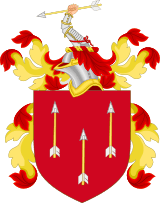 Coat of Arms of Nathan Hale | |
| Signature | |
|
| |
Nathan Hale (June 6, 1755 – September 22, 1776) was an American soldier and spy for the Continental Army during the American Revolutionary War. He volunteered for an intelligence-gathering mission in New York City but was captured by the British and executed. Hale has long been considered an American hero and, in 1985, he was officially designated the state hero of Connecticut.[1]
Background
Nathan Hale was born in Coventry, Connecticut, in 1755 to Richard Hale and Elizabeth Strong. In 1769, when he was fourteen years old, he was sent with his brother Enoch, who was sixteen, to Yale College. Nathan was a classmate of fellow patriot spy Benjamin Tallmadge.[2] The Hale brothers belonged to the Linonian Society of Yale, which debated topics in astronomy, mathematics, literature, and the ethics of slavery. Nathan graduated with first-class honors in 1773 at age 18 and became a teacher, first in East Haddam and later in New London.[3]
After the Revolutionary War began in 1775, he joined a Connecticut militia and was elected first lieutenant within five months.[4] His militia unit participated in the Siege of Boston, but Hale remained behind. It has been suggested that he was unsure as to whether he wanted to fight, or whether he was hindered because his teaching contract in New London did not expire until several months later, in July 1775. On July 4, 1775, Hale received a letter from his classmate and friend Benjamin Tallmadge, who had gone to Boston to see the siege for himself. He wrote to Hale, "Was I in your condition, I think the more extensive service would be my choice. Our holy Religion, the honor of our God, a glorious country, & a happy constitution is what we have to defend."[5] Tallmadge's letter was so inspiring that, several days later, Hale accepted a commission as first lieutenant in the 7th Connecticut Regiment under Colonel Charles Webb of Stamford.
In the following spring, the army moved to Manhattan Island to prevent the British from taking over New York City. In September, General Washington was desperate to determine the location of the imminent British invasion of Manhattan Island. To that end, Washington needed a spy behind enemy lines, and Hale was the only volunteer.[3]
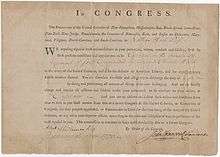 Commission of Nathan Hale captain in nineteenth regiment of foot commanded by Colonel Charles Webb. Signed by John Hancock. January 1, 1776 |
Nathan Hale as depicted in bronze (1890) by Frederick William MacMonnies at the Brooklyn Museum |
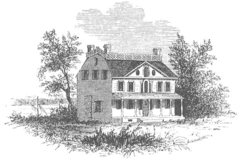 Beekman House, Manhattan |
Intelligence-gathering mission
The Battle of Long Island led to British victory and the capture of New York City via a flanking move from Staten Island across Long Island. Hale volunteered on September 8, 1776, to go behind enemy lines and report on British troop movements. He was ferried across on September 12. It was an act of spying that was immediately punishable by death and posed a great risk to Hale.
During his mission, New York City (then the area at the southern tip of Manhattan around Wall Street) fell to British forces on September 15 and Washington was forced to retreat to the island's north in Harlem Heights (what is now Morningside Heights).[6] On September 21, a quarter of the lower portion of Manhattan burned in the Great New York Fire of 1776. The fire was later widely thought to have been started by American saboteurs to keep the city from falling into British hands,[7] though Washington and the Congress had already denied this idea. It has also been speculated that the fire was the work of British soldiers acting without orders. In the fire's aftermath, more than 200 American partisans were rounded up by the British.
An account of Nathan Hale's capture was written by Consider Tiffany, a Connecticut shopkeeper and Loyalist, and obtained by the Library of Congress. In Tiffany's account, Major Robert Rogers of the Queen's Rangers saw Hale in a tavern and recognized him despite his disguise. After luring Hale into betraying himself by pretending to be a patriot himself, Rogers and his Rangers apprehended Hale near Flushing Bay in Queens, New York.[8] Another story was that his Loyalist cousin, Samuel Hale, was the one who revealed his true identity.
British General William Howe had established his headquarters in the Beekman House in a then rural part of Manhattan, on a rise between what are now 50th and 51st Streets between First and Second Avenues,[9] near where Beekman Place commemorates the connection. Hale reportedly was questioned by Howe, and physical evidence was found on him. Rogers provided information about the case. According to tradition, Hale spent the night in a greenhouse at the mansion. He requested a Bible; his request was denied. Sometime later, he requested a clergyman. Again, the request was denied.
According to the standards of the time, spies were hanged as illegal combatants. On the morning of September 22, 1776, Hale was marched along Post Road to the Park of Artillery, which was next to a public house called the Dove Tavern (at modern-day 66th Street and Third Avenue), and hanged.[10] He was 21 years old. Bill Richmond, a 13-year-old former slave and Loyalist who later became a boxer in Europe, was reportedly one of the hangmen, responsible for securing the rope to a strong tree and preparing the noose.[11]
Impact
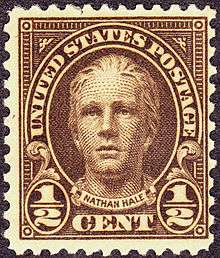
By all accounts, Hale comported himself well before the hanging.[12][13][14] Over the years, there has been speculation as to whether he specifically uttered the line: "I only regret that I have but one life to lose for my country."[15] The line may be a revision of "I am so satisfied with the cause in which I have engaged that my only regret is that I have not more lives than one to offer in its service."[16]
The story of Hale's quote began with John Montresor, a British officer who witnessed the hanging. Soon after the execution, Montresor spoke with the American officer William Hull about Hale's death. Hull later publicized Hale's use of the declaration. Because Hull was not an eyewitness to Hale's speech, some historians have questioned the reliability of the account.[10]
If Hale did not originate the statement, it is possible he instead repeated a passage from Joseph Addison's play Cato,[17] an ideological inspiration to many Whigs:
How beautiful is death, when earn'd by virtue!
Who would not be that youth? What pity is it
That we can die but once to serve our country.
No official records were kept of Hale's speech. However, Frederick MacKensie, a British officer, wrote this diary entry for the day:[12]
He behaved with great composure and resolution, saying he thought it the duty of every good Officer, to obey any orders given him by his Commander-in-Chief; and desired the Spectators to be at all times prepared to meet death in whatever shape it might appear.
It is almost certain that Nathan Hale's last speech contained more than one sentence. Several early accounts mention different things he said. These are not necessarily contradictory, but rather, together they give an idea of what the speech must have been like. (The following quotes are all taken from George Dudley Seymour's book, Documentary Life of Nathan Hale, published in 1941 by the author.)
From the diary of Enoch Hale, Nathan's brother, after he went to question people who had been present, October 26, 1776: "When at the Gallows he spoke & told them that he was a Capt in the Cont Army by name Nathan Hale."[18]
From the Essex Journal, February 13, 1777: "However, at the gallows, he made a sensible and spirited speech; among other things, told them they were shedding the blood of the innocent, and that if he had ten thousand lives, he would lay them all down, if called to it, in defence of his injured, bleeding Country."[19]
From the Independent Chronicle and the Universal Advertiser, May 17, 1781: "I am so satisfied with the cause in which I have engaged, that my only regret is, that I have not more lives than one to offer in its service."[16]
From the memoirs of Captain William Hull, quoting British Captain John Montresor, who was present and who spoke to Hull under a flag of truce the next day:
"On the morning of his execution," continued the officer, "my station was near the fatal spot, and I requested the Provost Marshal [William Cunningham] to permit the prisoner to sit in my marquee, while he was making the necessary preparations. Captain Hale entered: he was calm, and bore himself with gentle dignity, in the consciousness of rectitude and high intentions. He asked for writing materials, which I furnished him: he wrote two letters, one to his mother and one to a brother officer. He was shortly after summoned to the gallows. But a few persons were around him, yet his characteristic dying words were remembered. He said, 'I only regret, that I have but one life to lose for my country.'"[20]
Two early ballads also attempt to recreate Hale's last speech. Songs and Ballads of the Revolution, collected by F. Moore (1855) contained the "Ballad of Nathan Hale" (anonymous), dated 1776: "Thou pale king of terrors, thou life's gloomy foe, Go frighten the slave; go frighten the slave; Tell tyrants, to you their allegiance they owe. No fears for the brave; no fears for the brave.";[21] and "To the Memory of Capt. Nathan Hale" by Eneas Munson, Sr., was written soon after Hale's death:[22]
Hate of oppression's arbitrary plan,
The love of freedom, and the rights of man;
A strong desire to save from slavery's chain
The future millions of the western main,
And hand down safe, from men's invention cleared,
The sacred truths which all the just revered;
For ends like these, I wish to draw my breath,"
He bravely cried, "or dare encounter death."
And when a cruel wretch pronounced his doom,
Replied, "'Tis well, —for all is peace to come;
The sacred cause for which I drew my sword
Shall yet prevail, and peace shall be restored.
I've served with zeal the land that gave me birth,
Fulfilled my course, and done my work on earth;
Have ever aimed to tread that shining road
That leads a mortal to the blessed God.
I die resigned, and quit life's empty stage,
For brighter worlds my every wish engage;
And while my body slumbers in the dust,
My soul shall join the assemblies of the just.
Munson had tutored Hale before college, and knew him and his family well, so even though the particulars of this speech may be unlikely, Munson knew firsthand what Hale's opinions were.
Hanging site

Aside from the site at 66th Street and Third Avenue, three other sites in Manhattan claim to be the hanging site:
- City Hall Park, where a statue designed by Frederick William MacMonnies was erected in 1890[23]
- Inside Grand Central Terminal[23]
- The Yale Club at 44th Street and Vanderbilt Avenue, near Grand Central Terminal, the Daughters of the American Revolution (DAR) hung a plaque which states the event occurred "near" that site.[24]
Another account placed Hale's execution at Bergen Beach, Brooklyn, but there was no evidence to support this claim.[25]
Nathan Hale's body has never been found. His family erected an empty grave cenotaph in Nathan Hale Cemetery in South Coventry Historic District, Connecticut.[2]
Relatives
Hale was the great-grandson of John "Reverend Hale" Hale, an important figure in the Salem witch trials of 1692. Nathan Hale was also the uncle of orator and statesman Edward Everett (the other speaker at Gettysburg) and the grand-uncle of Edward Everett Hale (quoted above), a Unitarian minister, writer, and activist noted for social causes including abolitionism. He was the uncle of Nathan Hale who founded the Boston Daily Advertiser, and helped establish the North American Review.[26]
Legacy
Statues and appearance
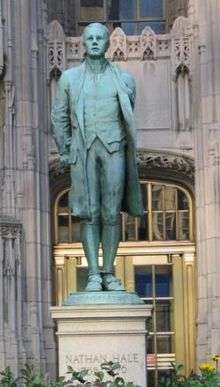
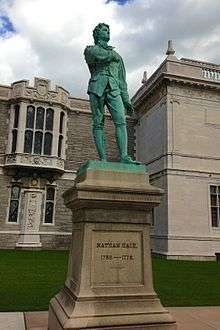
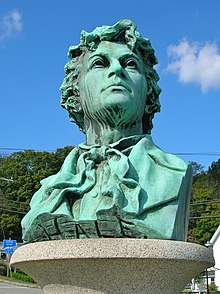
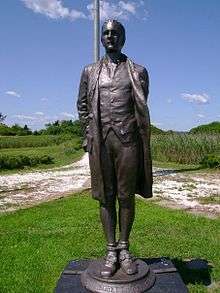
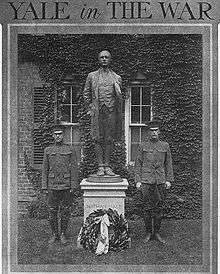
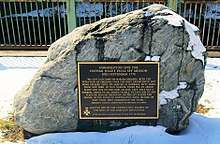
Statues of Nathan Hale are based on idealized archetypes; no contemporaneous portraits of him have been found.[2][27] Documents and letters reveal Hale was an informed, practical, detail-oriented man who planned ahead.[2] Of his appearance and demeanor, fellow soldier Lieutenant Elisha Bostwick wrote that Nathan Hale had blue eyes, flaxen blond hair, darker eyebrows, and stood slightly taller than average height (of the time), with mental powers of a sedate mind and pious. Bostwick wrote:[2][28]
I can now in imagination see his person & hear his voice- his person I should say was a little above the common stature in height, his shoulders of a moderate breadth, his limbs strait & very plump: regular features—very fair skin—blue eyes—flaxen or very light hair which was always kept short—his eyebrows a shade darker than his hair & his voice rather sharp or piercing—his bodily agility was remarkable. I have seen him follow a football and kick it over the tops of the trees in the Bowery at New York, (an exercise which he was fond of)—his mental powers seemed to be above the common sort—his mind of a sedate and sober cast, & he was undoubtedly Pious; for it was remark'd that when any of the soldiers of his company were sick he always visited them & usually Prayed for & with them in their sickness.[28]
Hale has been honored with two standing images:
- A statue designed by Frederick William MacMonnies was dedicated on the anniversary of Evacuation Day, November 25, 1893, at City Hall Park, New York.[29] The statue established Hale's modern idealized square-jawed image.
- A statue of Hale, sculpted 1908–12 by Bela Pratt, was cast in 1912 and stands in front of Connecticut Hall where he resided while at Yale. Copies of this sculpture stand at the Phillips Academy in Andover, Massachusetts; the Nathan Hale Homestead in Coventry; the Connecticut Governor's Residence in Hartford, Connecticut; Fort Nathan Hale in New Haven, Connecticut; Mitchell College in New London, Connecticut; the Department of Justice in Washington, D.C.; Tribune Tower in Chicago; and at the headquarters of the Central Intelligence Agency, Langley, Virginia.[30]
Other statues/markers include:
- A statue of Nathan Hale, with an inscription of his reported last words on the first floor of the Connecticut State Capitol in Hartford.[31] Statues of Nathan Hale are also located in the Tulane University Law School reading room; and at the corner of Summit and Portland Avenues in Saint Paul, Minnesota.[32]
- A memorial for him located in Huntington, New York where he landed for his fatal spying mission.
- A historical marker in Freese Park, Norwalk, Connecticut that is denoted as the embarkation point.[33]
- A 45-foot (14 m) obelisk known as the Captain Nathan Hale Monument was erected in his honor in 1846 in his birthplace of Coventry, Connecticut.
Namesake items
- The hamlet of Halesite, New York (formerly Huntington Harbor) on Long Island, New York, is named after Hale. There is a memorial plaque set into a large boulder, which was removed from the beach nearby where Hale is thought to have landed on his fateful mission.
- Nathan Hale Army Depot, a U.S. Army installation, is located in Darmstadt, Germany.
- Fort Nathan Hale, a Revolutionary War-era fort and historic site in New Haven, Connecticut, is named after him.
- The Nathan Hale Inn and Nathan Hale dormitory on the University of Connecticut campus in Storrs, Connecticut, are named after Hale.
- The Nathan Hale dormitory, traditionally a freshman girl's dorm, at Phillips Academy in Andover, Massachusetts, is named after Hale.
- Nathan Hale Hall is a Building at Farmingdale State College in Farmingdale, New York, which is home to Biology and Art Centers.
- Nathan Hale Hall is a Barracks Building at Fort George G. Meade, Maryland.
- Nathan Hale Hall is the main academic building at Mitchell College, New London, Connecticut.
- Nathan Hale Memorial Chapter Daughters of the American Revolution. Organized June 6, 1900, in East Haddam, Connecticut. Ceremony took place at the one-room schoolhouse where he once taught.
- High schools named after Hale include Nathan Hale-Ray High School in East Haddam, Connecticut (where he was schoolmaster), Nathan Hale High School in Seattle and high schools in West Allis, Wisconsin, and Tulsa, Oklahoma.
- Middle schools named after Hale include Nathan Hale-Ray Middle School in East Haddam, Connecticut, Nathan Hale Middle School in Norwalk, Connecticut (the departure point for his final mission), Captain Nathan Hale Middle School in Coventry, Connecticut (his birthplace), as well as middle schools in Northvale, New Jersey; Omaha, Nebraska; Cleveland; and Crestwood, Illinois.[34]
- There are elementary schools named after Hale in Roxbury, Boston; New London, Connecticut (where he was schoolmaster); Enfield, Connecticut; Manchester, Connecticut; Meriden, Connecticut, New Haven, Connecticut, Whiting, Indiana; Schaumburg, Illinois; Mesa, Arizona; Minneapolis; Lansing, Illinois, Crestwood, Illinois, Carteret, New Jersey, Northvale, New Jersey, and in Chicago.
- The United States Navy submarine USS Nathan Hale (SSBN-623) was named in his honor.
- The Nathan Hale Ancient Fife and Drum Corps from Coventry, Connecticut, is named after him and includes a division called Knowlton's Connecticut Rangers.
- "Nathaniel Hale" Battalion is the name of the Battalion for Army ROTC based at the University of Connecticut, with Knowlton Company (Company A) at University of Connecticut and Sillman Company (Company B) at Sacred Heart University.
See also
Notes and references
Notes
- ↑ "Sites, Seals, Symbols". Interactive Connecticut State Register & Manual. State of Connecticut. 2006. Archived from the original on December 16, 2006. Retrieved January 4, 2007.
- 1 2 3 4 5 Mobed, Desiree; Baker, Mary Beth. "FAQ". The Nathan Hale website. Archived from the original on November 1, 2006. Retrieved January 22, 2007.
- 1 2 "Capt. Nathan Hale (1755-1776) - Sons of the American Revolution, Connecticut - CTSSAR". www.connecticutsar.org. Retrieved January 16, 2016.
- ↑ "Nathan Hale: Yale 1773 :: Curator: Richard E. Mooney". www.library.yale.edu. p. 2. Retrieved January 16, 2016.
- ↑ "Documentary Life of Nathan Hale". google.com.
- ↑ Neff, p. 299–308.
- ↑ "Nathan Hale". Retrieved February 9, 2007.
- ↑ Hutson, James (July–August 2003). "Nathan Hale Revisited— A Tory's Account of the Arrest of the First American Spy". Information Bulletin. The Library of Congress. Retrieved February 9, 2007.
- ↑ Haswell, p. 22.
- 1 2 Ortner, Mary J. (2001). "Captain Nathan Hale (1755 - 1776)". Patriots. The Connecticut Society of the Sons of the American Revolution. Archived from the original on July 5, 2008. Retrieved February 9, 2007.
- ↑ "Colonial Era through the Antebellum Period". March 1, 2007. Archived from the original on March 1, 2007. Retrieved January 16, 2016.
- 1 2 Seymour, p. 292.
- ↑ Seymour, p. xxxi.
- ↑ Seymour, p. 438.
- ↑ Donnelly, F. K. (January 1, 1985). "A Possible Source for Nathan Hale's Dying Words". The William and Mary Quarterly. 42 (3): 394–396. doi:10.2307/1918934. JSTOR 1918934.
- 1 2 Seymour, p. 327.
- ↑ Seymour, p. xxxii.
- ↑ Seymour, p. 301.
- ↑ Seymour, p. 303.
- ↑ Seymour, p. 310.
- ↑ Seymour, p. 356.
- ↑ Seymour, p. 361.
- 1 2 "Permanent Revolution". New York magazine. September 10, 2012.
- ↑ https://untappedcities.com/2011/02/11/nathan-hale-banana-republic/
- ↑ Black, Frederick R. (1981). "JAMAICA BAY: A HISTORY" (PDF). United States Department of the Interior, National Park Service: 11–12.
- ↑ Sherman, Sherman (1885). "The Century". 29. New York, NY: The Century Co.: 339.
- ↑ George Dudley Seymour (1907). The familiar Hale: an attempt to show by what standards of age, appearance and character the proposed statue to Nathan Hale for the campus of Yale college should be judged. The Yale publishing association. pp. 6–7. Retrieved October 17, 2010.
- 1 2 "The Last Days and Valiant Death of Nathan Hale". American Heritage Magazine. American Heritage Inc. April 1964. Archived from the original on September 29, 2007. Retrieved January 22, 2007.
- ↑ "City Hall Park, Nathan Hale". New York City Department of Parks and Recreation.
- ↑ "The CIA campus. A walk outside headquarters". Central Intelligence Agengy. July 9, 2009. Retrieved July 10, 2014.
- ↑ "ConneCT Kids Connecticut Government The Connecticut State Capitol 4". Retrieved September 13, 2014.
- ↑ "Nathan Hale". Saint Paul Minnesota. Retrieved September 25, 2017.
- ↑ "NATHAN HALE: Patriot Spy" (PDF). Revolutionary Connecticut. Retrieved 15 February 2017.
- ↑ "Archived copy". Archived from the original on August 20, 2008. Retrieved September 24, 2007.
- "St. Paul, Minnesota government". Retrieved September 13, 2014.
References
- H. W. Crocker III (2006). Don't Tread on Me. New York: Crown Forum. ISBN 978-1-4000-5363-6.
- Charles Haynes Haswell (1896). Reminiscences of New York by an octogenarian (1816 to 1860). Harper. Retrieved October 17, 2010.
- Jacob K. Neff (1845). The Army and Navy of America: containing a view of the heroic adventures, battles, naval engagements, remarkable incidents, and glorious achievements in the cause of freedom, from the period of the French and Indian Wars to the close of the Florida War : independent of an account of warlike operations on land and sea : enlivened by a variety of the most interesting anecdotes, and splendidly embellished with numerous engravings. John S. Gable. Retrieved October 17, 2010.
- George D. Seymour (May 2006). Documentary Life of Nathan Hale: Comprising All Available Official and Private Documents Bearing on the Life of the Patriot. Kessinger Publishing. ISBN 978-1-4286-0043-0. Retrieved October 17, 2010.
Further reading
- Baker, Mark Allen. "Spies of Revolutionary Connecticut, From Benedict Arnold to Nathan Hale." Charleston: The History Press, 2014. ISBN 978-1-62619-407-6
- Circian. "The Story of Nathan Hale." Archiving Early America. N.p., 2011. Web. October 3, 2011. <http://www.earlyamerica.com/review/2001_summer_fall/n_hale.html>.
- Fleming, Thomas. "George Washington, Spymaster." American Heritage. American Heritage Publishing Company, 2011. Web. October 3, 2011. <http://www.americanheritage.com/content/george-washington-spymaster>.
- Durante, Dianne, Outdoor Monuments of Manhattan: A Historical Guide (New York University Press, 2007): description of MacMonnies's Nathan Hale at City Hall Park, New York.
- Kirby, David. "Nathan Hale Was Here . . . and Here . . . and Here." New York Times November 23, 1997: 3. <http://search.proquest.com/docview/430873870>.
- Miller, Tom. "The Lost 1763 Beekman Mansion 'Mount Pleasant'—50th Street and 1st Avenue." Daytonian in Manhattan. N.p., September 21, 2011. Web. October 3, 2011. <http://daytoninmanhattan.blogspot.com/2011/09/lost-1763-beekman-mansion-mount.html>.
- Ortner, Mary J. "Captain Nathan Hale." The Connecticut Society of the Sons of the American Revolution. N.p., 2010. Web. October 3, 2011. <https://web.archive.org/web/20080705134759/http://www.connecticutsar.org/patriots/hale_nathan_2.htm>.
- Phelps, William M. "Nathan Hale: The Life and Death of America's First Spy" St. Martin's Press, New York, New York, 2008. ISBN 0-312-37641-3
- Rose, Alexander. Washington's Spies: The Story of America's First Spy Ring. Random House, New York, New York, 2006. ISBN 0-553-80421-9.
External links
| Wikimedia Commons has media related to Nathan Hale. |
| Wikiquote has quotations related to: Nathan Hale |
- A Time for Heroes: The Story of Nathan Hale

- Ortner, Mary J. (2001). "Captain Nathan Hale (1755–1776)". The Connecticut Society of the Sons of the American Revolution. Archived from the original on July 5, 2008. Retrieved November 3, 2009.
- Hutson, James. "Nathan Hale Revisited". Information Bulletin: July/August 2003. Library of Congress.
[A newly discovered] account of the capture of Nathan Hale fits the facts as we know them so well that one is tempted to accept it as being substantially true.
- "Nathan Hale, American Patriot". U-S-History.com.
- The Connecticut Society of the Sons of the American Revolution
- Nathan Hale at Find a Grave